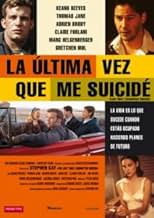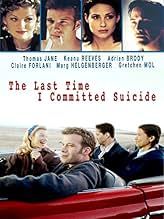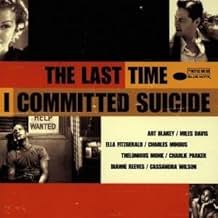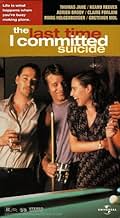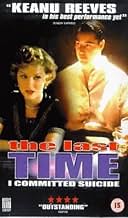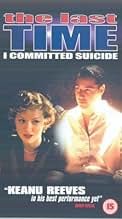AVALIAÇÃO DA IMDb
5,4/10
2,5 mil
SUA AVALIAÇÃO
Adicionar um enredo no seu idiomaIn 1946 Denver, an aspiring writer who enjoys irresponsible adventures with his friend writes a letter about his life before and after the suicide attempt by his sad, commitment-seeking girl... Ler tudoIn 1946 Denver, an aspiring writer who enjoys irresponsible adventures with his friend writes a letter about his life before and after the suicide attempt by his sad, commitment-seeking girlfriend.In 1946 Denver, an aspiring writer who enjoys irresponsible adventures with his friend writes a letter about his life before and after the suicide attempt by his sad, commitment-seeking girlfriend.
Cristine Rose
- Mrs. Greenway
- (as Christine Rose)
- Direção
- Roteiristas
- Elenco e equipe completos
- Produção, bilheteria e muito mais no IMDbPro
Avaliações em destaque
To appreciate this film the viewer needs either to be in a jazzy, rebellious sort of mood, or have some interest in Neal Cassady, an American who figured heavily in the development of the "beat generation" of the 1950s.
Set in the 1940s during one notable period of Cassady's life, the film is mostly a character study of Cassady (Thomas Jane), and his relationship with other people in his life, including his friend Harry (Keanu Reeves) and various romantic interests, the central one being Joan (Claire Forlani).
But Cassady was a quirky kind of guy, a rebel, a nonconformist, fun loving, with a restless energy, a person constantly on the move, both physically and philosophically. As presented in the film, he is a cross between James Dean and Jim Morrison.
Cassady's offbeat personality is mirrored in the film's offbeat style. It's shot partly in color and partly in B&W. Plot structure seems deliberately chaotic, frenetic, loose. Jump cuts can be jarring for viewers expecting a smoothly flowing, linear plot. And the tone alternates between silly and philosophical. Background music is mostly jazz with some blues thrown in. Accordingly, a lot of viewers will find the film's unorthodox style off-putting.
But I liked it, for the most part. The plot would have been stronger if it had focused on Cassady's 1950s relationship with other historical figures, like Jack Kerouac and Allen Ginsberg, instead of his romances with random women. Otherwise, the cinematography, the music, and the performance of Thomas Jane are terrific.
Set in the 1940s during one notable period of Cassady's life, the film is mostly a character study of Cassady (Thomas Jane), and his relationship with other people in his life, including his friend Harry (Keanu Reeves) and various romantic interests, the central one being Joan (Claire Forlani).
But Cassady was a quirky kind of guy, a rebel, a nonconformist, fun loving, with a restless energy, a person constantly on the move, both physically and philosophically. As presented in the film, he is a cross between James Dean and Jim Morrison.
Cassady's offbeat personality is mirrored in the film's offbeat style. It's shot partly in color and partly in B&W. Plot structure seems deliberately chaotic, frenetic, loose. Jump cuts can be jarring for viewers expecting a smoothly flowing, linear plot. And the tone alternates between silly and philosophical. Background music is mostly jazz with some blues thrown in. Accordingly, a lot of viewers will find the film's unorthodox style off-putting.
But I liked it, for the most part. The plot would have been stronger if it had focused on Cassady's 1950s relationship with other historical figures, like Jack Kerouac and Allen Ginsberg, instead of his romances with random women. Otherwise, the cinematography, the music, and the performance of Thomas Jane are terrific.
Seeing this film for the first time is like being introduced to that friend or lover you always dreamed about. Neal Cassady, the hero of Jack Kerouac's On The Road and Visions Of Cody, comes to life on the screen, having the same effect as James Dean used to; as the old cliche goes: women want him, men want to be him. Taken from a letter Cassady wrote to good ol' Jack, the story meanders around the lives of Cassady, his pool hall boozer friend Harry, and his lovely but melancholy girlfriend Joan (played exquisitely by Claire Forlani, who is in my humble opinion one of the most beautiful and gifted people working in Hollywood today). So, not to give too much of the plot away, Neal manages to have his decisions made for him; whether this is by fate or by his own personality is left up to the viewer. Stephen Kay follows Cassady and recreates a legend before our eyes. And whoever discovered Thomas Jane deserves a big ol' kiss. The film delivers, and the spirit of the Beats once again is given a voice and, as it were, an image.
"this was not the last time I committed suicide..." That's such an amazing line. It's all about how you make certain choices that could make the world of difference in your future, how the road you have just chosen to take might not be the one that you most want -- but for some reason you take it anyways. That by one choice, you are killing a life that you might've had. It's a great movie! And the ending is wonderful! It's so bittersweet, so honest. It makes me wish that things were as easy as they were then. That like Neal Cassady, I could just drop everything, hop into a stolen car, and ride away --- doesn't matter where, just away.
"The Last Time I Committed Suicide" is an excellent description of live of a beatnick in the 50s. Thomas Jane does a good performance in a quaint leading roll, but he is duly overshadowed by the young rising Godesses of Hollywood; namely Claire Forlani and Gretchen Mol. These two girls have seen their careers boom as of late much due to their looks and screen sensuality. This bunch of new talent has one advantage over Keanu Reeves, who takes on a minor part in this movie. They are not yet typecast. Keanu did well for himself considering. However, what struck me the most was the mood portrayed in the movie. It was calm yet restless, poetic yet true to life. When we add the excellent choice of music we have a movie worthy a life at the top shelf.
Seeing that the whole movie is based on a letter from Neal Cassidy to Jack Kerouac, I reckon Stephen Kay did an excellent job of re-creating the essence that was Cassidy and his neer-do-well existence.
You felt for Neal (played very well by Thomas Jane ). He could almost taste the sweetness of a well balanced life - the honey at home the white picket fence the dog running around in the yard, but circumstance (his likings for the female of the species, penchant for stealing cars and his friendship with good 'ol HARRY [played brilliantly by KEANU REEVES]), just got in the way of true happiness.
The supporting cast give good all round performances, especially Claire Forlani as the girl of Cassidy's 'dreams'.
This movie catches the 'beat' excellently with great visuals and a Class A soundtrack.
Highly recommended.
You felt for Neal (played very well by Thomas Jane ). He could almost taste the sweetness of a well balanced life - the honey at home the white picket fence the dog running around in the yard, but circumstance (his likings for the female of the species, penchant for stealing cars and his friendship with good 'ol HARRY [played brilliantly by KEANU REEVES]), just got in the way of true happiness.
The supporting cast give good all round performances, especially Claire Forlani as the girl of Cassidy's 'dreams'.
This movie catches the 'beat' excellently with great visuals and a Class A soundtrack.
Highly recommended.
Você sabia?
- CuriosidadesThe letter on which this movie is based was referred to by its author Neal Cassady, and its recipient Jack Kerouac as "the Joan Anderson letter" (even though the only extant fragment more prominently and dramatically dealt with a different girlfriend of Neal's at the time, nicknamed Cherry Mary). This letter, written in December 1950 about events in Cassady's life from the summer through Christmas of 1945, was "lost" circa 1954 and 1955. But before that happened, a 5,000-word fragment (on which this movie is based) had been copied (retyped) likely by Kerouac himself, and was subsequently published in 1964 in a small San Francisco literary magazine called "Notes From Underground", then again later in Cassady's posthumous autobiography "The First Third" (beginning "To have seen a specter isn't everything ..."). The entire 16,000-word letter by Cassady - which Kerouac had praised as a turning point in his approach to writing - was never seen again after 1955 - and consequently became something of a Holy Grail in the Beat world. Miraculously, in 2012, the entire letter was found after nearly sixty years in old boxes that had been stored since being rescued from the Sausalito publisher Golden Goose's garbage when it folded in 1955. It's set for auction on December 17, 2014.
- Erros de gravaçãoDianne Reeves wasn't born until 1956 but her "Jingle Bells" is used in the soundtrack.
- Citações
Neal Cassady: One startled look and I knew, I was right back where I'd started.
- Cenas durante ou pós-créditosThe film is introduced with these sentences:
A man's life is merely a collection of events, building one upon the other. When all the events are tallied: the triumphs; the failures; the mistakes, their sum makes up the man.
These are but a few events in the life of "Superman".
- Trilhas sonorasBetter Get It in Your Soul
Written by Charles Mingus
Performed by Charles Mingus
Courtesy of Columbia Records
Principais escolhas
Faça login para avaliar e ver a lista de recomendações personalizadas
- How long is The Last Time I Committed Suicide?Fornecido pela Alexa
Detalhes
- Data de lançamento
- País de origem
- Idioma
- Também conhecido como
- Sem Limites
- Locações de filme
- Empresas de produção
- Consulte mais créditos da empresa na IMDbPro
Bilheteria
- Orçamento
- US$ 4.000.000 (estimativa)
- Faturamento bruto nos EUA e Canadá
- US$ 46.362
- Fim de semana de estreia nos EUA e Canadá
- US$ 12.836
- 22 de jun. de 1997
- Faturamento bruto mundial
- US$ 46.362
- Tempo de duração1 hora 32 minutos
- Cor
- Mixagem de som
- Proporção
- 1.85 : 1
Contribua para esta página
Sugerir uma alteração ou adicionar conteúdo ausente


